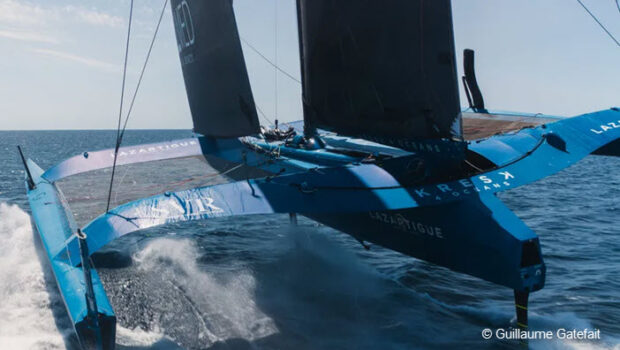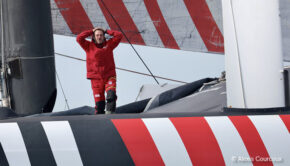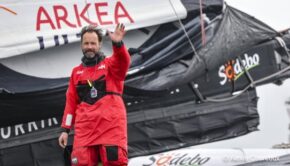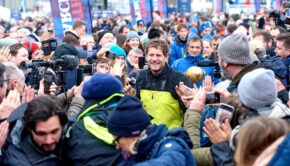Collision in ARKEA ULTIM CHALLENGE
Published on January 18th, 2024
(January 18, 2024; Day 12) – The question at the start of the ARKEA ULTIM CHALLENGE-Brest was whether all six maxi trimarans would complete their solo non-stop race round the world. After Armel Le Cléac’h (Maxi Banque Populaire XI) rallied from a 27-hour pitstop in Brazil for repairs, Tom Laperche (SVR Lazartigue) has issues that may not be so recoverable.
Laperche’s daggerboard in the main hull collided with an UFO (unidentified floating object) at around 0430hrs UTC today while in second place some 1300 nm west of Cape Town, with the damage sufficient to cause a significant leak. The solo skipper Laperche is now heading towards Cape Town with the water ingress under control.
“I had been working pretty well all night,” reported the 26 year old skipper this afternoon, “I had found good sail configurations and settings, and we were moving neither too fast nor too slow with a good average and speeds of around 35 knots.
“Towards the end of the night I felt a huge shock in a big crash. Hitting the daggerboard damaged the bottom of the hull and in a fraction of a second, water was coming into the central section. I walked around the boat quickly and realized that the boat was remaining controllable. We had to slow down as much as possible and furl up the sails. We must now bring the boat in as undamaged as possible.”
The damage has been stabilized, Laperche is safe and being assisted by his technical team to try to bring the Trimaran SVR-Lazartigue to Cape Town. He was around 80 miles behind race leader Charles Caudrelier (Maxi Edmond de Rothschild) when the collision occurred.
“We now have to manage the next four days at sea without it getting any worse,” reports Laperche. “I managed to set the boat up in the right direction and am not to go too fast. I will monitor water levels and the daggerboard movements. We still have 35 knots of wind but it should ease in a little over a day with calmer seas. I remain in contact with the whole team and we will try to find the best solutions to reach Cape Town.”
“The impact was quite violent because the boat was moving at 35 knots at the time of the collision,” said Team Manager Cécile Andrieu. “We are in permanent contact with him to analyze as best as possible the damage to the boat, contain it and find the best route to reach Cape Town where his arrival is estimated on Monday morning (Jan. 22). The entire technical team is gathered in Concarneau and will leave for Cape Town to be with Tom. We will study the options for the future.”
Meantime race leader Caudrelier expressed his dismay and solidarity with the young rival with whom he had been dueling since the start. Caudrelier on the powerful Verdier designed ULTIM had seemed to be threatening the 24 hour solo sailing record last night with a run to 841 miles, some ten miles short of the record set in November 2017 by François Gabart en route to the current solo round the world record of 42 days.
“As there is less pressure on me, I don’t need to watch the speed as much as when Tom was there,” admitted Caudrelier. “I took advantage to tidy things up and give the boat a big check. We had been racing at a crazy pace. The atmosphere has changed now. And the way we sail.”
Caudrelier has now more than 700 miles in hand over third placed Thomas Coville (Sodebo Ultim 3). The leader is at the front of a low pressure front which should push him at least as far as the Kerguelen Islands at the same kind of speeds in good sea conditions. This evening, the Maxi Sodebo 3 gybed to stay in the depression which he hopes to ride over the coming days to stay in contact. Fourth and fifth, Actual Ultim 3 and Banque Populaire XI, will have to negotiate lighter winds.
“I am offshore of Rio de Janeiro and the passage down the Brasilian coast has been long, we are downwind now and starting to get some breeze, I have 20 knots now, it is still warm and I am in light clothing which helps when I have maneuvers to do,” shared Le Cléac’h .
“But it will cool down quickly. We are having to go in a quite southerly direction and that is the program for the future, it is a bit of a long route but by the weekend the temperature will be down and we will get to the south. I am catching a few miles on Antho’ who is a bit to my east. It is bad news about Tom I hope he can get back in the race soon.”
Details: https://arkeaultimchallengebrest.com/en
The Ultim Class trimarans have a maximum length of 32 meters and a maximum width of 23 meters.
The solo speed record around the world was set in 2017 by François Gabart (FRA) on the 30m Macif trimaran in a time of 42d 14h 40m 15s for an average speed of 21.08 knots. This yacht has been rebranded and will be raced by Marchand.
Entrants:
• Charles Caudrelier (FRA), Maxi Edmond de Rothschild (2017 Verdier 32/23)
• Thomas Coville (FRA), Sodebo Ultim 3 (2019 VPLP/others 32/23)
• Tom Laperche (FRA), Trimaran SVR-Lazartigue (2021 VPLP 32/23)
• Armel Le Cléac’h (FRA), Maxi Banque Populaire XI (2021 VPLP 32/23)
• Anthony Marchand (FRA), Actual Ultim 3 (2015 VPLP 30/22)
• Éric Péron (FRA), Trimaran Adagio (2014 VPLP 31/21)*
* Only entrant without foiling appendages
Five rules from the Sailing Instructions:
• The start line is kept open for 168 hours and the finish line is closed after an elapsed time of 100 days after the start time, that is to say 16th April 2024.
• The skippers can communicate and exchange with their teams on shore, so they have the freedom to get weather information and be routed by their team on shore and get technical help and advice to help with technical problems.
• The solo skippers can stop but there are two distinct operations. A technical stop is unassisted and requires the sailor to drop anchor, take a mooring, or tie up alongside an anchored or moored boat with no external help. There is no time penalty for a technical stop. But for a technical stopover (escale technique) where one or more crew or technical team come on board to help, there is a mandatory 24 hours minimum. This does not apply to the start port of Brest where all means are authorized to reach or leave the port within a radius of 50 miles.
• For the first time in ocean racing, zones where there are known to be a high concentration of whales and sea mammals are determined. Establishing these zones should both protect the marine wildlife and reduce the chance of a collision. These zones are around the Azores, the Canaries, south of South Africa, the Kerguelens, and parts of the Antarctic.
• There are ice exclusion zones to protect the skippers and their boats.









 We’ll keep your information safe.
We’ll keep your information safe.